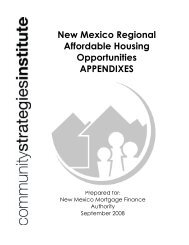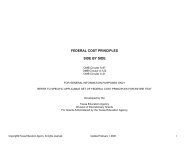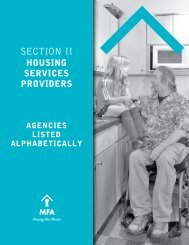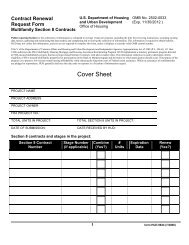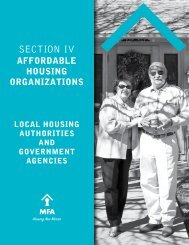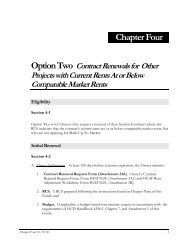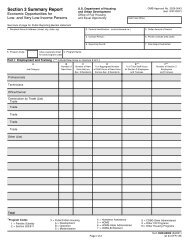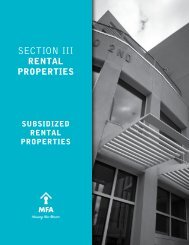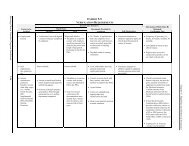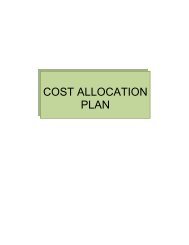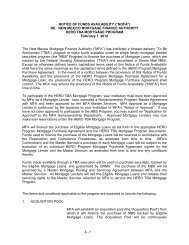2008 CAPER Tables - MFA - Housing New Mexico
2008 CAPER Tables - MFA - Housing New Mexico
2008 CAPER Tables - MFA - Housing New Mexico
You also want an ePaper? Increase the reach of your titles
YUMPU automatically turns print PDFs into web optimized ePapers that Google loves.
Form HUD-60002, Section 3 Summary Report, Economic Opportunities for Low- and Very Low-Income Persons.<br />
Instructions: This form is to be used to report annual<br />
accomplishments regarding employment and other economic<br />
opportunities provided to low- and very low-income persons under<br />
Section 3 of the <strong>Housing</strong> and Urban Development Act of 1968. The<br />
Section 3 regulations apply to any public and Indian housing<br />
programs that receive: (1) development assistance pursuant to<br />
Section 5 of the U.S. <strong>Housing</strong> Act of 1937; (2) operating assistance<br />
pursuant to Section 9 of the U.S. <strong>Housing</strong> Act of 1937; or (3)<br />
modernization grants pursuant to Section 14 of the U.S. <strong>Housing</strong> Act<br />
of 1937 and to recipients of housing and community development<br />
assistance in excess of $200,000 expended for: (1) housing<br />
rehabilitation (including reduction and abatement of lead-based paint<br />
hazards); (2) housing construction; or (3) other public construction<br />
projects; and to contracts and subcontracts in excess of $100,000<br />
awarded in connection with the Section-3-covered activity.<br />
Form HUD-60002 has three parts, which are to be completed for<br />
all programs covered by Section 3. Part I relates to employment<br />
and training. The recipient has the option to determine numerical<br />
employment/training goals either on the basis of the number of hours<br />
worked by new hires (columns B, D, E and F). Part II of the form<br />
relates to contracting, and Part III summarizes recipients’ efforts to<br />
comply with Section 3.<br />
Recipients or contractors subject to Section 3 requirements must<br />
maintain appropriate documentation to establish that HUD financial<br />
assistance for housing and community development programs were<br />
directed toward low- and very low-income persons.* A recipient of<br />
Section 3 covered assistance shall submit one copy of this report to<br />
HUD Headquarters, Office of Fair <strong>Housing</strong> and Equal Opportunity.<br />
Where the program providing assistance requires an annual<br />
performance report, this Section 3 report is to be submitted at the<br />
same time the program performance report is submitted. Where an<br />
annual performance report is not required, this Section 3 report is to be<br />
submitted by January 10 and, if the project ends before December 31,<br />
within 10 days of project completion. Only Prime Recipients are<br />
required to report to HUD. The report must include<br />
accomplishments of all recipients and their Section 3 covered<br />
contractors and subcontractors.<br />
HUD Field Office: Enter the Field Office name .<br />
1. Recipient: Enter the name and address of the recipient<br />
submitting this report.<br />
2. Federal Identification: Enter the number that appears on the<br />
award form (with dashes). The award may be a grant,<br />
cooperative agreement or contract.<br />
3. Dollar Amount of Award: Enter the dollar amount, rounded to the<br />
nearest dollar, received by the recipient.<br />
4 & 5. Contact Person/Phone: Enter the name and telephone number<br />
of the person with knowledge of the award and the recipient’s<br />
implementation of Section 3.<br />
6. Reporting Period: Indicate the time period (months and year)<br />
this report covers.<br />
7. Date Report Submitted: Enter the appropriate date.<br />
8. Program Code: Enter the appropriate program code as listed at<br />
the bottom of the page.<br />
9. Program Name: Enter the name of HUD Program corresponding<br />
with the “Program Code” in number 8.<br />
Part I: Employment and Training Opportunities<br />
Column A: Contains various job categories. Professionals are<br />
defined as people who have special knowledge of an occupation (i.e.<br />
supervisors, architects, surveyors, planners, and computer<br />
programmers). For construction positions, list each trade and provide<br />
data in columns B through F for each trade where persons were<br />
employed. The category of “Other” includes occupations such as<br />
service workers.<br />
Column B: (Mandatory Field) Enter the number of new hires for<br />
each category of workers identified in Column A in connection with<br />
this award. <strong>New</strong> hire refers to a person who is not on the contractor’s<br />
or recipient’s payroll for employment at the time of selection for the<br />
Section 3 covered award or at the time of receipt of Section 3 covered<br />
assistance.<br />
Column C: (Mandatory Field) Enter the number of Section 3 new<br />
hires for each category of workers identified in Column A in<br />
connection with this award. Section 3 new hire refers to a Section 3<br />
resident who is not on the contractor’s or recipient’s payroll for<br />
employment at the time of selection for the Section 3 covered award or<br />
at the time of receipt of Section 3 covered assistance.<br />
Column D: Enter the percentage of all the staff hours of new hires<br />
(Section 3 residents) in connection with this award.<br />
Column E: Enter the percentage of the total staff hours worked for<br />
Section 3 employees and trainees (including new hires) connected<br />
with this award. Include staff hours for part-time and full-time<br />
positions.<br />
Column F: (Mandatory Field) Enter the number of Section 3<br />
residents that were trained in connection with this award.<br />
Part II: Contract Opportunities<br />
Block 1: Construction Contracts<br />
Item A: Enter the total dollar amount of all contracts awarded on the<br />
project/program.<br />
Item B: Enter the total dollar amount of contracts connected with this<br />
project/program that were awarded to Section 3 businesses.<br />
Item C: Enter the percentage of the total dollar amount of contracts<br />
connected with this project/program awarded to Section 3 businesses.<br />
Item D: Enter the number of Section 3 businesses receiving awards.<br />
Block 2: Non-Construction Contracts<br />
Item A: Enter the total dollar amount of all contracts awarded on the<br />
project/program.<br />
Item B: Enter the total dollar amount of contracts connected with this<br />
project awarded to Section 3 businesses.<br />
Item C: Enter the percentage of the total dollar amount of contracts<br />
connected with this project/program awarded to Section 3 businesses.<br />
Item D: Enter the number of Section 3 businesses receiving awards.<br />
Part III: Summary of Efforts – Self -explanatory<br />
Submit one (1) copy of this report to the HUD Headquarters Office of<br />
Fair <strong>Housing</strong> and Equal Opportunity, at the same time the<br />
performance report is submitted to the program office. The Section 3<br />
report is submitted by January 10. Include only contracts executed<br />
during the period specified in item 8. PHAs/IHAs are to report all<br />
contracts/subcontracts.<br />
* The terms “low-income persons” and very low-income persons” have<br />
the same meanings given the terms in section 3 (b) (2) of the United<br />
States <strong>Housing</strong> Act of 1937. Low-income persons mean families<br />
(including single persons) whose incomes do not exceed 80 percent of<br />
the median income for the area, as determined by the Secretary, with<br />
adjustments for smaller and larger families, except that<br />
The Secretary may establish income ceilings higher or lower than 80 percent<br />
of the median for the area on the basis of the Secretary’s findings such that<br />
variations are necessary because of prevailing levels of construction costs<br />
or unusually high- or low-income families. Very low-income persons mean<br />
low-income families (including single persons) whose incomes do not<br />
exceed 50 percent of the median family income area, as determined by the<br />
Secretary with adjustments or smaller and larger families, except that the<br />
Secretary may establish income ceilings higher or lower than 50 percent of<br />
the median for the area on the basis of the Secretary’s findings that such<br />
variations are necessary because of unusually high or low family incomes.<br />
Page i form HUD 60002 (11/2010)<br />
Ref 24 CFR 135



